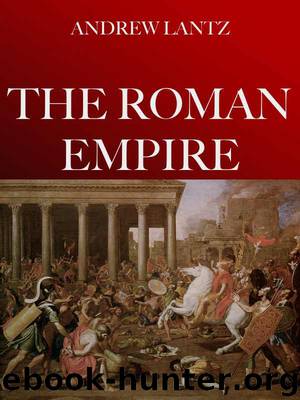Dreams of Augustus: The Story of the Roman Empire by Andrew Lantz

Author:Andrew Lantz [Lantz, Andrew]
Language: eng
Format: azw3
Tags: Justinian, Roman Empire, Augustus, Caesar, Constantine, Byzatine Empire
Publisher: History Coalition Press
Published: 2013-11-24T05:00:00+00:00
24
The New Rome
The Roman Empire was not the first Christian state. In 301, the Armenian king Tiradates accepted Christianity as the official religion of his kingdom. Christianity was also a rising force in Ethiopia and would become an official religion of that kingdom in 330.
Nevertheless, the transformation of the Roman Empire into Christianity was probably the most significant moment in the history of that religion. Before Constantine, only 10% of the Roman population was Christian. These Christians were primarily concentrated in the east although all the major cities in the Empire had Christian communities. After Constantine, that percentage exploded.
Beyond genuine faith, the value of Christianity to an emperor like Constantine is not that hard to see. Roman emperors had always claimed that the gods were on their side. Most of them had even been declared a god after their death. Constantine used Christianity for similar purposes. While not claiming to be God's equal, he was just one step below Him. He would use divine favor as one more way to cement his rule.
In addition, a religion like Christianity could create a common bond amongst the people living in the Empire. For that to happen, however, there needed to be unity in belief. During Constantine's time, that was not the case within the Christian community.
As any religion grows in power and importance, there's bound to be two things that emerge: a hierarchy and different sects. Over the previous centuries, there had emerged Christian leaders in the cities and towns of the Empire called bishops. Naturally, the bishops of the major cities became more powerful than those of the small towns. In the east, the bishops of Alexandria in Egypt, Antioch in Syria and the holy city of Jerusalem became the most prominent bishops. In the west, the bishops of Rome and Carthage were influential.
These bishops became known as Patriarchs, the so-called fathers of the church. The Patriarch of Rome, the chief city of the Empire, became known as the Pope.
Officially, these Patriarchs were the leaders of the “universal” church. This became known as the Catholic Church.
There also emerged different sects of Christianity that, while all acknowledging Jesus as being the son of God, differed over the details.
During the fourth century, Christians became bitterly divided over the nature of Jesus. Most Christians believed that there was a time where God existed and Jesus did not. Because God created Jesus, Jesus was separate from, and therefore, inferior to God.
Because a priest in Alexandria named Arius was the most famous proponent of this point of view, it is known as Arianism (not to be confused with the Aryanism of Hitler).
The contrary view was that that the father, son and Holy Spirit were just different manifestations of God. All three have always existed and are all omnipresent, omnipotent, infinitely wise, infinitely holy, infinitely loving and omniscient. This concept is called the Holy Trinity.
If this doesn't make sense, just think of the controversy as being about whether God was superior to Jesus. The Arians said yes, the opponents of Arianism said no.
Download
This site does not store any files on its server. We only index and link to content provided by other sites. Please contact the content providers to delete copyright contents if any and email us, we'll remove relevant links or contents immediately.
The Vikings: Conquering England, France, and Ireland by Wernick Robert(79845)
Ali Pasha, Lion of Ioannina by Eugenia Russell & Eugenia Russell(40103)
The Conquerors (The Winning of America Series Book 3) by Eckert Allan W(36960)
The Vikings: Discoverers of a New World by Wernick Robert(36903)
Cecilia; Or, Memoirs of an Heiress — Volume 1 by Fanny Burney(32396)
Cecilia; Or, Memoirs of an Heiress — Volume 3 by Fanny Burney(31775)
Cecilia; Or, Memoirs of an Heiress — Volume 2 by Fanny Burney(31744)
Empire of the Sikhs by Patwant Singh(22922)
The Secret History by Donna Tartt(18787)
Hans Sturm: A Soldier's Odyssey on the Eastern Front by Gordon Williamson(18448)
Cat's cradle by Kurt Vonnegut(15126)
Pimp by Iceberg Slim(14255)
Sapiens: A Brief History of Humankind by Yuval Noah Harari(14183)
Talking to Strangers by Malcolm Gladwell(13156)
Norse Mythology by Gaiman Neil(13154)
Leonardo da Vinci by Walter Isaacson(13128)
4 3 2 1: A Novel by Paul Auster(12245)
Underground: A Human History of the Worlds Beneath Our Feet by Will Hunt(11992)
The Radium Girls by Kate Moore(11886)
